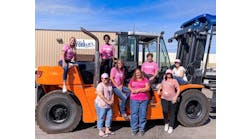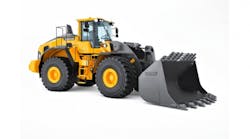Rental companies, equipment dealers, owners and users of all types of equipment must meet certain standards to assure the safe operation of that equipment. Those standards are clearly spelled out in the American National Standards Institute's “Manual of Responsibilities.” For those involved in the use or rental of aerial work platforms, the standards, which have been in effect since 1990, were recently updated to address a number of issues including the responsibility of the dealer with regards to operator training and familiarization upon delivery.
According to the 2006 version of the ANSI standards, a dealer is defined as “a person or entity who buys from a manufacturer or distributor and who generally sells, rents and services aerial platforms.” This definition applies to boomlifts, scissorlifts and other types of aerial equipment.
The Standards further state that the dealer “shall offer appropriate training to facilitate owners, users and operators to comply with requirements set forth in the standard regarding the inspection, maintenance, use, application and operation of the aerial platform.” Dealers shall also conduct “familiarization upon delivery,” which includes providing information regarding the control functions and safety devices for the aerial platform(s), and identifying and confirming the location of the appropriate manuals stored on the machine to a person designated by the receiving entity. Note that the word ‘shall’ is to be understood as mandatory.
So what does all this mean? What do you as a rental company need to do to conform to the 2006 version of the standards? Do you have to set up a training department in your facility? Do you need to send your staff to a “train-the-trainer” class? Do you have to change the way you are doing business? The answer is that you probably will have to make some changes, but not as many as you may think.
Let's look at familiarization first. You need to inform those renting your equipment that they now have to designate a receiving entity or have the operator who is going to use the machine available to receive familiarization when equipment is delivered. So your delivery entity must be properly trained to conduct familiarization to this person at each delivery. Familiarization includes the identification of the manual storage compartment, confirmation that all manuals are in place, and a review of the control functions and safety devices specific to the machine being delivered.
The standards also state that the dealer must retain a record of the person receiving familiarization and the person who provided the familiarization for at least four years. If your delivery personnel are driving up to the jobsite, unloading the aerial device and driving away without providing familiarization, you will have to change the way you work.
Training
“Training” is a more complex matter. Previously, the ANSI Standards read, “Whenever the dealer directs or authorizes an individual to operate an aerial platform, the dealer shall ensure that the individual has been trained under the direction of a qualified person.” But they didn't define who was to conduct the training; only that it was the dealer's responsibility to make sure it was done. The new Standards now say, “The dealer shall offer appropriate training…”
Note the word “offer.” It is now clear that the dealer does not have to actually conduct training; he just has to offer it and make it reasonably available to the user. It is the user's responsibility to make sure that the person operating the equipment has received the necessary training.
Training can be conducted by the dealer, by a manufacturer's trainer, by an independent training center or by other means. Many dealers have a dedicated staff that have completed a “Train-the-Trainer” program and are qualified to conduct operator training. Finding potential trainers within a rental company can be easier than it sounds as many “Train-the-Trainer” programs not only focus on what to teach, they also cover how to teach it. With a qualified trainer on staff some dealers establish a separate training center within their organization and offer training as an additional source of revenue. Regardless of who conducts the training, a record of who was trained along with the person who conducted the training must be recorded and retained for at least four years from the date of initial training.
Once it is understood who is responsible for conducting the training, it is equally important to understand what constitutes training. In the Standards section covering “Responsibilities of Operators,” ANSI clarifies the type of training required by stating, “Only personnel who have received instructions regarding the inspection, application and operation of aerial platforms, including recognition and avoidance of hazards associated with their operation, shall operate an aerial platform.” They further state, “Under the direction of a qualified person the trainee shall operate the aerial platform for a sufficient period of time to demonstrate proficiency in the actual operation of the aerial platform.”
Clearly, to meet the requirements set forth in the current ANSI Standards, operator training requires both instruction and hands-on operation. To get a better idea of what should be included in an operator-training program, we contacted JLG Industries to see what they cover. JLG has been conducting operator training for many years and today offers one of the widest selections of English and Spanish language training programs available.
Programs include aerial work platform and telehandler operator and “Train-The-Trainer” safety training, and service training programs, parts training programs, and even programs in sales training. Courses last from four hours to three days depending on the course content, number of trainees and their level of experience.?
Although classes are usually held at one of the JLG facilities in McConnellsburg, Pa.; Orville, Ohio; Kennesaw, Ga.; Houston; or Las Vegas, they are also held on-site at a customer's location. In either case, it is important to limit class size and conduct the training in a controlled learning environment to maximize trainees' learning experience. Training can be instructor led or provided via pre-recorded media. Some general instruction is also available over the Internet.
While instruction doesn't have to be conducted by an instructor in-person, the benefits of personal training can be great. Instructor-led training can focus more closely on an individual trainee's needs, such as explaining why test answers were wrong or providing answers to questions not specifically addressed in the session. It can also provide job-specific training that would be unavailable from a pre-recorded program. And, if an instructor is present, he or she can better assess the trainee's comprehension of the materials presented.
For the basic operator-training course, JLG begins each session by discussing the importance of safety and how a comprehensive training program will help prevent accidents on the jobsite. They follow with a review of current rules, regulations and standards including the ANSI/SIA Manual of Responsibilities, manufacturer-supplied manuals, relevant local and OSHA standards plus applicable safety placards and decals placed on the machine.
Items such as the requirements for personal fall-protection equipment and the factors affecting the stability of the machine are covered. Trainers also discuss how to recognize and avoid other hazards when operating the equipment.?
JLG then covers the specific machine type upon which the trainee is being trained. They discuss the various applications for the machine, the specific controls and machine functions so that the trainee can operate and maneuver the machine safely. They review emergency procedures and how to handle them. They discuss the need for a comprehensive pre-start inspection that includes a walk-around inspection of the machine, a test of all machine functions to make sure they are operating properly and an inspection of the worksite to recognize potential hazards. Once this has been completed, a written test is administered to assure the trainee's comprehension of materials covered.
Hands-on
After the written test, trainees then move on to the hands-on part of the training. This portion of the training program must always be conducted under the direction and guidance of a qualified instructor according to ANSI Standards. During this hands-on portion the trainee must operate the machine for a sufficient period of time to demonstrate proficiency in actual operation.
It is the instructor's responsibility to critique the trainee's performance and determine if the trainee has the ability to carry out a task in a sufficiently correct and proper manner to be considered a qualified person. Following the successful completion of the hands-on operation, general safety instruction and written testing, trainees are awarded personalized Operator Cards to recognize their accomplishment.
Whether rental companies utilize manufacturer-developed programs such as JLG's, or offer other qualified programs, it is the responsibility of the rental company to offer training that allows them to comply with current ANSI Standards, to all owners, users and operators. And remember, it isn't just your customers that require training. If anyone in your rental company operates a machine, whether moving it around your service area or conducting a sales demonstration, they are considered the user in that situation and you are required to make sure that those individuals have been properly trained and familiarized with the equipment.
William Hindman is president of Industrial Marketing Services, Elk Grove Village, Ill.


